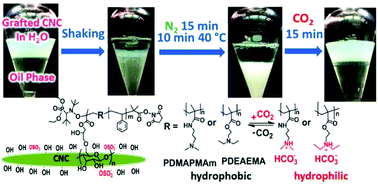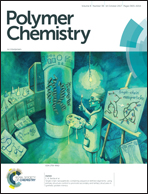Grafting well-defined CO2-responsive polymers to cellulose nanocrystals via nitroxide-mediated polymerisation: effect of graft density and molecular weight on dispersion behaviour†
Abstract
A grafting to approach on a cellulose derivative using reversible deactivation radical polymerisation (RDRP) is reported for the first time. SG1-capped poly(N,N-(diethylamino)ethyl methacrylate) (PDEAEMA) and poly(N-3-(dimethylamino) propyl methacrylamide) (PDMAPMAm) macroalkoxyamines of different molecular weights, showing low dispersity, high livingness and end group fidelity were grown in bulk through Nitroxide-Mediated Polymerisation (NMP) using the alkoxyamine N-hydroxysuccinimidyl BlocBuilder® (NHS-BlocBuilder). In the second step, these CO2-responsive macroalkoxyamines were grafted to glycidyl methacrylate (GMA) modified cellulose nanocrystals (CNC) to obtain CO2-responsive CNC. Two different tertiary amine polymers were selected to investigate how differences in their pKaH and Tg affected the final properties of the graft-modified CNC. The effect of the macroalkoxyamines molecular weight on the graft density was investigated in detail and was shown to have a direct influence on the dispersion behaviour and CO2-responsiveness of the grafted CNC particles, as demonstrated by zeta potential measurements in water and phase shuttling experiments between oil and water. The results suggested that a particular pKaH, minimum graft density and graft length are required to effectively switch the CNC from a hydrophilic to a fully hydrophobic state.



 Please wait while we load your content...
Please wait while we load your content...